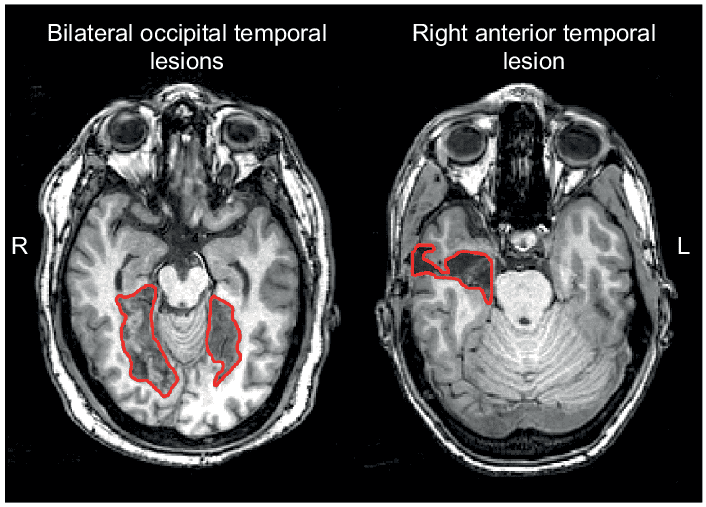Imagine what it’s like to forget the face of your spouse, parents, or best friend or not be able to recognize your favorite actor when watching a movie. Even though these are rare situations, there are some who can’t remember the faces of strangers they often meet in common contexts. Up to 1 in 50 people have this problem. It’s called prosopagnosia (or face blindness).

Prosopagnosia makes people unable to recognize faces, even when they’ve seen them dozens of times before, although many lead normal lives without even realizing they have it. In some very extreme cases, some might have difficulties identifying their own face in mirrors or photos.
What is prosopagnosia?
The first mentions of this odd condition can be traced back to antiquity, but the earliest formal description dates from a 1947 report written by Dr. Joachim Bodamer. Bodamer wrote about two individuals with face recognition deficit, a disorder which he would later call prosopagnosia (“prosopon” means “face” in Greek and “agnosia” means “ignorance”).
Not a lot of people know about prosopagnosia, and for decades, the condition received little attention — but things have changed recently after the American actor Brad Pitt confessed he believes he suffers from prosopagnosia (although he never received an official diagnosis). In 2013 Pit told Esquire that, in the past, he’d ask people to remind him of where or when they met, but “people were more offended.”
“So many people hate me because they think I’m disrespecting them,” Pitt said at the time. “You get this thing, like, ‘You’re being egotistical. You’re being conceited.’ But it’s a mystery to me, man. I can’t grasp a face and yet I come from such a design/aesthetic point of view.”
Famous conservationist Jane Goodall also reportedly suffers from this condition. Goodall, who famously studies chimps, is also unable to distinguish some chimp faces from others, so her condition extends to non-human faces as well.
“I had no trouble with those who had obvious physical characteristics – unusual bone structure, beaky nose, extreme beauty, or the opposite. But with other faces I failed, miserably,” she said. “Sometimes I knew that people were upset when I did not immediately recognize them – certainly I was. And because I was embarrassed, I kept it to myself,” Goodall writes in her autobiographical book.
It is not known when Pitt’s and Goodall’s problem started or what caused it, but previous research has provided valuable insights from a neuroscience perspective.
Forgetting a face

The first thing to about prosopagnosia is that it comes in two forms: acquired and developmental.
Acquired prosopagnosia (AP) can be caused by severe incidents like brain damage, stroke, trauma, or degenerative diseases. People with AP are aware they have this condition because before their traumatic accident they used to be good at remembering people’s faces.
Developmental prosopagnosia (DP) occurs early in life (typically from birth) and it can be caused by neurodevelopmental impairments or may be genetically inherited. People with DP do not develop normal face recognition abilities. Sometimes, they are not aware they have a problem, because this is how they have perceived faces their whole life and don’t have another reference experience.
There are ways to see whether or not someone has prosopagnosia, from brain imaging to pen-and-paper tests. The most effective diagnostic tool is the Benton Facial Recognition Test, in which people are shown a picture of a face they must recognize from a set of portraits.
The brain and face processing

There are three main regions in the brain responsible for face processing: the occipital face area (OFA) in the inferior occipital gyrus, the fusiform face area (FFA) in the middle fusiform gyrus, and the posterior parts of the superior temporal sulcus.
In patients with AP, one or more of these regions are damaged; usually, the back of the brain is damaged, either bilaterally or in the right hemisphere, but lesions can also occur in the occipitotemporal areas. For people with DP, things are a little different, because their problem is not caused by brain damage. In fact, there is no visible brain abnormality; their neurological network seems intact, but they have difficulty recognizing faces. There are, however, some slight differences in structural and white-matter connectivity in individuals with DP compared to people with normal face recognition.
These areas of the brain are not the only ones involved in processing faces. Scientists have studied event-related potentials (ERPs) to understand how the brain reacts when exposed to faces compared to inanimate objects. ERPs are small voltages generated in the brain in response to sensory, cognitive, or motor events.
Their findings show that the brain can tell the difference between faces and objects by the magnitude of impulses, with faces generating a more negative potential than objects. This potential can have a response of 170 milliseconds (known as the N170 component) or 250 milliseconds (the N250 component).
N170 is what helps the brain recognize that a stimulus is the face of a person and not an object. According to a study, some people with AP did not show any activation of the N170 component when looking at faces. What’s more, their N170 response was the same when the subjects were exposed to a face or a house.
The other component, N250, is what puts a name to a face. The process is quite simple. When we see a person’s face, N250 stores the representation of that face in the visual memory, so we can remember and recognize the person we see.
An experiment demonstrated that people with DP can identify only 30% of the faces they see, compared to individuals without this condition who can recognize up to 80% of the faces. The interesting part is that N250 was activated when it was exposed to faces that the DP patients claimed to not recognize. This demonstrates that the component can function and activate representations in visual memory, but the participants still don’t have the ability to remember faces.
The steps of face recognition
It’s not entirely clear what causes prosopagnosia, but recent research suggests it could be linked to abnormalities, deformations, or damage in some parts of the brain. According to two British scientists, Vicki Bruce and Andy Young, there are four steps to achieving face recognition — and understanding those could also help us understand.
- The first step is structural encoding, in which the structural features of a face are recorded by the brain.
- The second step is matching the results of structural encoding with previously stored information about a familiar face, which is contained in the face recognition units (FRUs).
- After that, the identity-specific semantic codes are accessed through person identity nodes (PINs).
- Finally, there’s the last step: name retrieval, which means linking a person’s face with an identity.
For people with AP and DP, the face recognition process is atypical. They can encounter problems in any of the four stages. For instance, they might find it difficult to identify certain details of a person’s face or they may have a hard time associating a face with a name.
Recognizing a face but not being able to pinpoint the person’s name or identity is not prosopagnosia and should not be confused with it
Related problems
All these difficulties prompt people with prosopagnosia to seek alternative methods of recognizing people, such as their voice, perfume, clothes, etc. These may seem reliable, but, unlike a person’s face, these indicators can vary, so they are not always helpful. People change their clothes and they might even talk differently the next time you meet them.
But the problems do not stop here. Prosopagnosia likely causes some collateral problems. Social anxiety is a common one; individuals are afraid to develop relationships and friendships because they can’t remember the people they meet. What’s worse, in extreme cases, they can’t even properly enjoy their time alone, like something as simple as watching a movie, because they have difficulties remembering the actors’ faces and they can’t follow the plot.
Scientists have not yet discovered a treatment for prosopagnosia, but they are reportedly working on programs that could improve face recognition. Meanwhile, researchers at the Centre for Face Processing Disorders have come up with a list of coping mechanisms that could help individuals with AP and DP. They suggest identifying people through conversation and specifically asking them to reintroduce themselves and studying photographs to memorize people’s facial features.
Although prosopagnosia is a rare medical condition, it has a huge impact on people’s lives. Patients may feel that they are in a state of constant amnesia in terms of the appearance of other individuals and this can take a toll on their social lives and mental wellbeing. And while we know quite a few things about prosopagnosia, a treatment is nowhere in sight.


